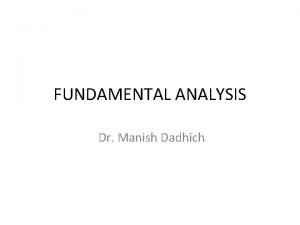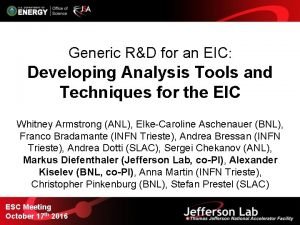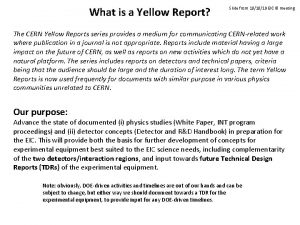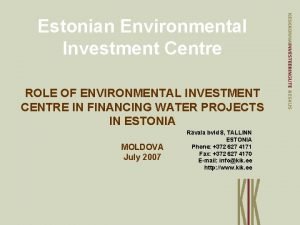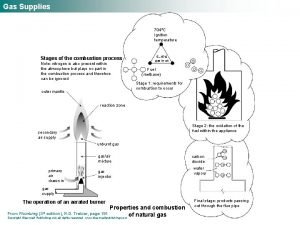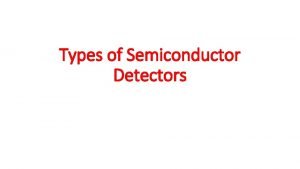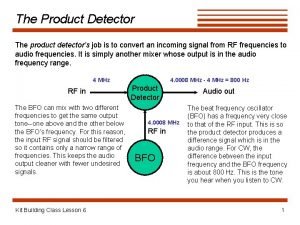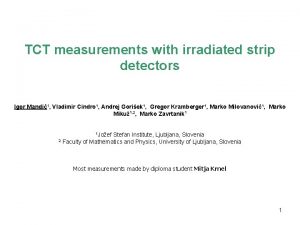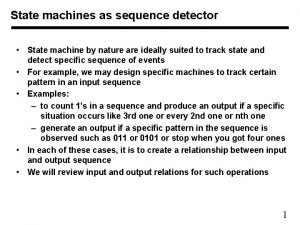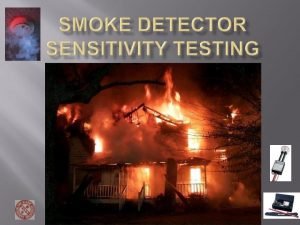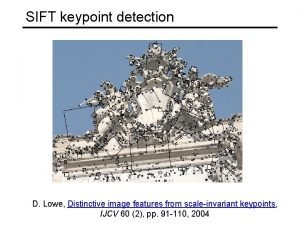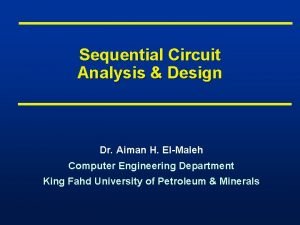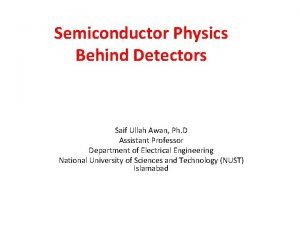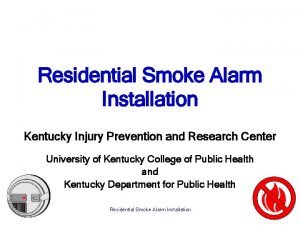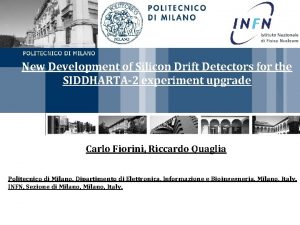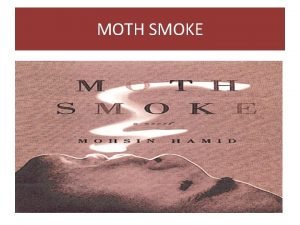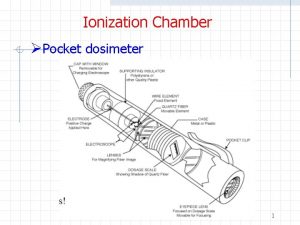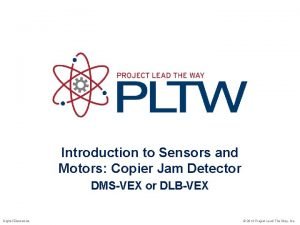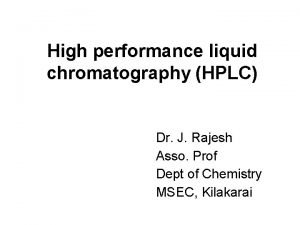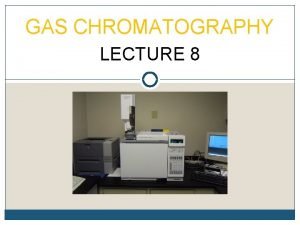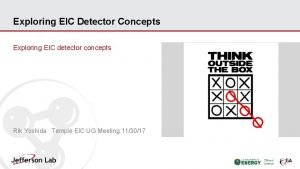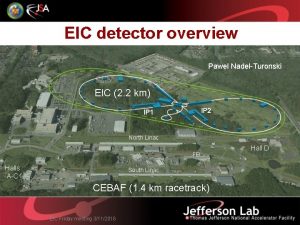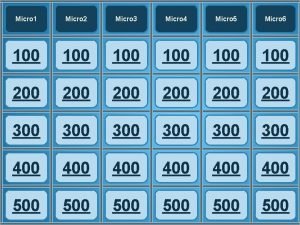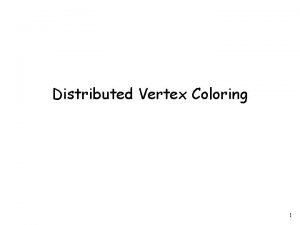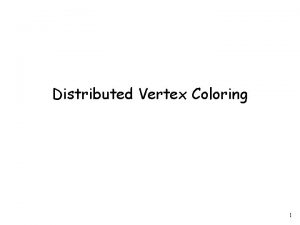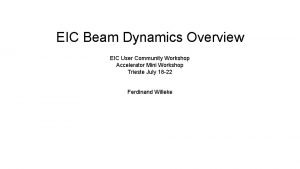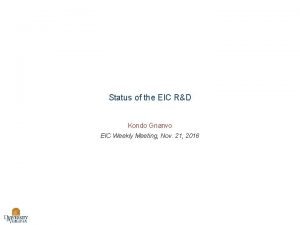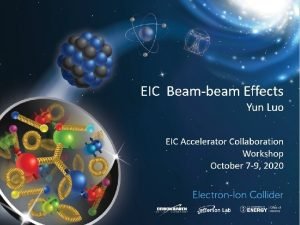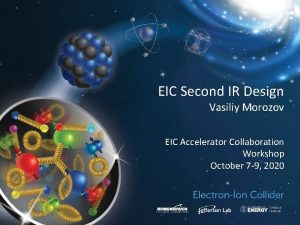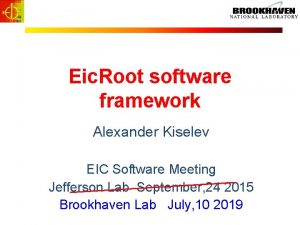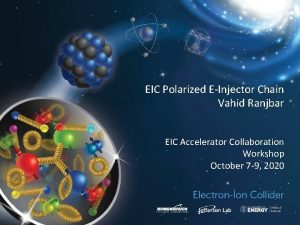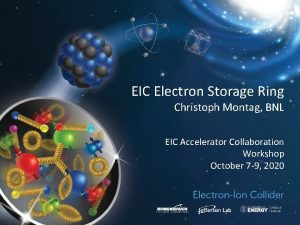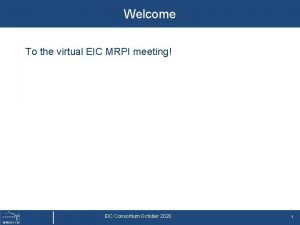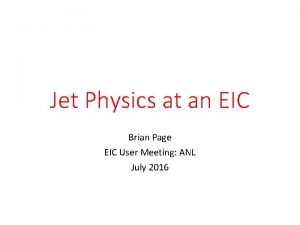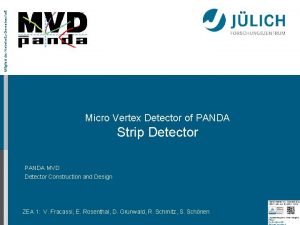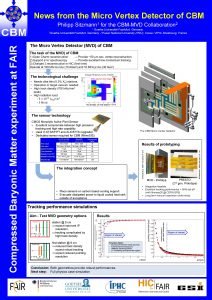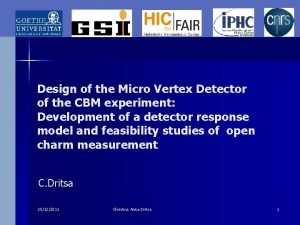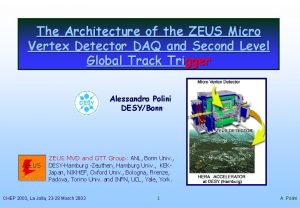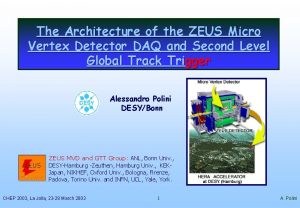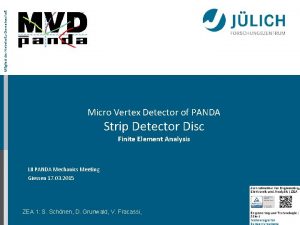A Micro Vertex System in a EIC Detector





























- Slides: 29

A Micro Vertex System in a EIC Detector based on Monolithic Active Pixel Sensors Benedetto Di Ruzza (BNL) 2013 Fall Meeting of the APS Division of Nuclear Physics 12/13/2021 October 23 -26, 2013; Newport News, Virginia Benedetto Di Ruzza DNP-2013 Meeting 1

Most Compelling SCIENCE Questions at an EIC spin physics imaging what is the polarization of gluons at what is the spatial distribution of small x where they are most abundant quarks and gluons in nucleons/nuclei what is the flavor decomposition of understand deep aspects of gauge the polarized sea depending on x theories revealed by k. T dep. distribution determine quark and gluon Contributions possible window to to the proton spin at last orbital angular momentum physics of strong color fields quantitatively probe the universality of strong color fields in AA, p. A, and e. A understand in detail the transition to the non-linear regime of strong gluon fields and the physics of saturation how do hard probes in e. A interact with the medium For details see in this meeting: Session KE: Mini-Symposium on the Physics Program at EIC http: //meetings. aps. org/Meeting/DNP 13/Session/KE 12/13/2021 Benedetto Di Ruzza DNP-2013 Meeting 2

e. RHIC: an EIC collider at BNL new e. RHIC Detector Collisions: ü Polarized electrons : 10, 20, (30? ) Ge. V ü Polarized protons : 75, 250 Ge. V ü Ions. 50, 100 Ge. V/u Keypoints: ü Electron beam: NEW High Energy ERL. ü Proton beam: NEW coherent electron cooling. New e-ring ü No other tunnel required: electron beam line will be added in the present RHIC tunnel. ü Up to 3 experimental locations available. 12/13/2021 Benedetto Di Ruzza DNP-2013 Meeting Present RHIC 3

Overview of the New e. RHIC Detector Silicon Micro Vertex Goals: high acceptance -5 < h < 5 central detector good PID (p, K, p and lepton) and vertex resolution (< 5 mm) tracking and calorimeter coverage the same good momentum resolution, lepton PID low material density minimal multiple scattering and brems-strahlung very forward electron and proton/neutron detection maybe dipole spectrometers 12/13/2021 Benedetto Di Ruzza DNP-2013 Meeting 4

A Silicon Micro Vertex for e. RHIC Vertex system based on Monolithic Active Pixel Silicon Sensor (MAPS) MAPS type candidate: MIMOSA Tests ongoing at BNL: MAPS Mimosa 26 (digital output) designed in the Institut Pluridisciplinaire Hubert Curien, Strasbourg (FR). Keypoints: ü All the sensor is produced using a standard CMOS technology. ü No Bump bonding required. ü Works at room temperature: low cooling material budget. ü Low bias voltage required: electrons are collected for thermal diffusion. ü High segmentation: pixel dimension ~20 x 20 mm 2 12/13/2021 Benedetto Di Ruzza DNP-2013 Meeting 5

A Silicon Micro Vertex Detector for e. RHIC MIMOSA 26: used in our test • 0. 35μm CMOS process (AMS: up to 4 metal layers), with high-resistivity epitaxial layer • Column architecture with in-pixel amplification (CDS) and end-of-column discrimination followed by zero suppression →binary charge encoding • Read-out in rolling shutter mode • Active area: 1152 columns of 576 pixels (21. 2× 10. 6 mm ^2) • Pitch: 18. 4 μm∼ 0. 7 million pixels • 2 outputs at 80 MHz (Data 1 and Data 2) • Power consumption ∼ 250 m. W/cm^2 (~520 u. W/col) • Readout frame time 112 us MIMOSA 28 (Ultimate): used in the STAR PXL upgrade • Same 0. 35μm CMOS process, different design of the array, keep all the other features MIMOSA 32 and 34: prototype under studies • 0. 18μm CMOS process (Tower. Jazz: up to 6 metal layers), with high-resistivity thick epitaxial layer (18 -40 um) • All the feature of the 26 and 28 • Studies ongoing to reduce the readout time to 30/40 us • Best candidate for a EIC detector for radiation hardness and thickness of sensors • best candidate for silicon MAPS wheel because of the two extra metal layers • Also approved for ITS ALICE upgrade, candidate for CBM and ILD detectors For the cooling system we are exploring the possibility of a micro channeling cooling system 12/13/2021 Benedetto Di Ruzza DNP-2013 Meeting 6

The BNL NASA Space Radiation Laboratory In this Lab there is one of the few beam-lines able to deliver many different type of ions. This beam line is mainly devoted to irradiation studies of electronic devices and biological tissue. We decided to make a test here in order to compare the clustering in the sensor using different type of Ions Beam-line characteristics: 1)beams of protons/heavy ions extracted from the BNL Booster accelerator 2)Available ions beams: iron-56, gold-97, silicon-28, protons, titanium, carbon 3)Beam spot tunable up to 10 x 10 cm 2 with spill duration of 0. 2 s every 4 s 4)Number of particle tunable until few/spill 12/13/2021 Benedetto Di Ruzza DNP-2013 Meeting 7

Irradiation with protons beam • Proton Energy: 1 Ge. V • DAQ Trigger: Fixed 4 k. Hz (no spill synchronization) • Beam intensity : 5000 particle/spill cm^2 Clustering in 50000 frames (Frame= read-out of the whole array) Hits distribution in 50000 frames (X, Y axis= um of one pixels array) High noise due to lots of empty frames (no synchronization) 12/13/2021 Benedetto Di Ruzza DNP-2013 Meeting 8

Irradiation with Silicon ions Silicon Ion Energy: 600 Me. V/U Sensor orientation: 45 degree DAQ Trigger: Fixed 4 k. Hz (with spill synchronization) • Beam intensity : 60000 particle/spill cm^2 • • • Clustering in 700 frames Occupancy in only one frame 12/13/2021 Benedetto Di Ruzza DNP-2013 Meeting 9

Irradiation with Iron beam Iron Ion Energy: 1 Ge. V/U Sensor orientation: 45 degree DAQ Trigger: Fixed 4 k. Hz (with spill synchronization) • Beam intensity : 7000 particle/spill cm^2 • • • Clustering in 50000 frames Clustering in 10000 frames 12/13/2021 Benedetto Di Ruzza DNP-2013 Meeting 10

Conclusions The present status of the MAPS technology confirms this silicon sensor type as the • best candidate for the inner tracking of a EIC/e. RHIC detector. • The new 0. 18 CMOS technology and the new design reduce a lot the readout time of the array. • The new 6 metal layer technology and the radiation hardness is the key for the construction of the wheels with MAPS technology, something completely new. • These wheels, with low mass will allow to high resolution ideal to get a good Dp/p in the forward direction. • In BNL we have unique beamline to develop these kind of prototypes and we are developing the know-how to do this. . • In this first test with maps under ions beam we realized that the noise level in the spare chip used was to high for good measurements, but we define the procedure to do this type of test. PLANS: In the future we want repeat these test with the new prototype MIMOSA 32 and 34 with digital and analog readout. Thanks for your attention ! This work was possible only thanks the efforts , the collaboration and help of all the BNL NSLR staff members, a special thanks to Michael Sivertz, Adam Rusek, Chiara La Tessa and Marta Rovituso This work was supported with BNL LDRD project #11 -036 12/13/2021 Benedetto Di Ruzza DNP-2013 Meeting 11

Links to EIC related information • e. RHIC BNL home page https: //wiki. bnl. gov/eic • e. RHIC BNL Collider Accelerator Department http: //www. bnl. gov/cad/e. Rhic/ • EIC White Paper http: //arxiv. org/abs/1212. 1701 • NASA Space Radiation Laboratory at Brookhaven http: //www. bnl. gov/medical/nasa/nsrl_description. asp • EIC Montecarlo page https: //wiki. bnl. gov/eic/index. php/Simulations • Call for EIC R&D proposals https: //wiki. bnl. gov/conferences/index. php/EIC_R%25 D • EIC R&D Simulation workshop (BNL October 8 TH -9 TH 2012) https: //wiki. bnl. gov/conferences/index. php/EIC_RD_Simulation/Agenda • Gluons and quark sea at high energies: Report on a ten week program that toke place at the Institute for Nuclear Theory (Seattle, Fall 2010) http: //: arxiv/abs/1108. 1713 For the latest resoults on the MIMOSA 32/34 see for example : Serhiy Senyukov (IPHC-CNRS Strasbourg)on behalf of the PICSEL group, (IPRD 13) 7 - 10 October 2013 Siena, Italy http: //www. bo. infn. it/sminiato/sm 13/abstract/S 2/s-senyukov. pdf 12/13/2021 Benedetto Di Ruzza DNP-2013 Meeting

Brookhaven National Laboratory RHIC NLS-II AGS Solar Farm 12/13/2021 Benedetto Di Ruzza DNP-2013 Meeting 13

BACK-UP Slides 12/13/2021 Benedetto Di Ruzza DNP-2013 Meeting

12/13/2021 Benedetto Di Ruzza DNP-2013 Meeting

Overview of the New Detector • Si-Vertex – MAPS technology from IPHC ala STAR, CBM, Alice, …) • Barrel: 4 double sided layers @ 3. 5. 5 8. 15. cm 10 sectors in F • Forward Disks: 4 single sided disks spaced in z starting from 20 cm, dual sided readout or GEM ? • Barrel Tracking – Preferred technology TPC (alternative GEM-Barrel tracker Mass? ) • Low mass, PID e/h via d. E/dx • Forward tracking – GEM-Trackers • Forward/Backward RICH-Detectors – Momenta to be covered: 0. 5 -80 Ge. V for 1<|y|<4(5) – Technology: • Dual Radiator (HERMES, LHCb) Aerogel+Gas (C 4 F 10 or C 4 F 8 O) – Photondetector: low sensitivity to magnetic field 12/13/2021 Benedetto Di Ruzza DNP-2013 Meeting

Overview of the New Detector • Barrel PID-Detectors – Momenta to be covered 0. 5 -10 Ge. V for -1<y<1 – Technology: • Aerogel Proximity focusing RICH • DIRC • ECal: – Backward/Barrel: • Pb. W-crystal calorimeter great resolution, small Molière radius electron-ID: e/p, measure lepton via Ecal, important for DVCS – Forward: • Less demanding: sampling calorimeter • Preshower – Si-W technology as proosed for PHENIX MPCEX • Hcal/Muons-Detectors – Not obvious they are really needed • Luminosity monitor, electron and hadron polarimeters 12/13/2021 Benedetto Di Ruzza DNP-2013 Meeting

Mimosa 26 : ü ü Silicon Vertex Matrix of 663 552 pixels: 576 lines x 1152 col. 13. 7 mm X 21. 5 mm Matrix Surface Pitch= 18 Sensitive volume thickness 15 ü Digital data stream after zero suppression See for details: http: //www. iphc. cnrs. fr/List-of-MIMOSA-chips. html MAPS implementation in the STAR Detector (Mimosa 28 Ultimate) http: //indico. scc. kit. edu/indico/get. File. py/ access? contrib. Id=6&res. Id=0&material. Id=slides&conf. Id=27 12/13/2021 Benedetto Di Ruzza DNP-2013 Meeting

How to see the gluons: Deep Inelastic Scattering Kinematics: Measure of resolution power Measure of inelasticity Measure of momentum fraction of struck quark Quark splits into gluon splits into quarks … Gluon splits into quarks 10 -16 m 10 -19 m 12/13/2021 Benedetto Di Ruzza DNP-2013 Meeting higher √s increases resolution 19

What needs to be covered e’ e g, p, J/Y g. L* (Q 2) x+ξ x-ξ ~ ~ H, H, E, E (x, ξ, t) p’ p t Inclusive Reactions: q q Momentum/energy and angular resolution of e’ critical Very good electron id Moderate luminosity >1032 cm-1 s-1 Need low x ~10 -4 high √s (Saturation and spin physics) Semi-inclusive Reactions: q q q Excellent particle ID: p, K, p separation over a wide range in h full F-coverage around g* Excellent vertex resolution Charm, bottom identification high luminosity >1033 cm-1 s-1 (5 d binning (x, Q 2, z, pt, F)) Need low x ~10 -4 high √s Exclusive Reactions: 12/13/2021 q Exclusivity high rapidity coverage rapidity gap events q high resolution in t Roman pots 33 cm-1 s-1 (4 d binning (x, Q 2, t, F)) q high luminosity >10 Benedetto Di Ruzza DNP-2013 Meeting 20

IP configuration for e. RHIC Pro s ele ns 2. 5 m From: Dejan Trbojevic (BNL) EIC RD Simulation 9 th of October 2012 on r t c DETECTOR ton s/Io 4. 5 m 0. 81 m 1. 512 m 1. 95 m 0. 993 m Interaction Point 0. 85 m 1. 53 m m D=120 m . 5) m (p o/2 1. 9 c 5. 475 m p c/2. 5 q=9. 82 mrad ad q=10 mr q=3. 5 mrad ZDC q=10 mrad IP 2 4 6 8 10 12 14 4. 50 m beam neutrons D=120 mm 12/13/2021 Benedetto Di Ruzza DNP-2013 Meeting 16

From: Dejan Trbojevic (BNL) EIC RD Simulation 9 th of October 2012 y DE 3 I S IN Quad 0. 3 2 m m 2 6 1 6 Electron quadrupoles 1 0 rad I 2. 5 rad 0 m q=1 8 1 4 z D C ) DE I S T OU 2. 5 p o/ m( 5. m 475 1 m 1. 5 m m rad s 0 mtron q=1 neu 1 2 m bea 678 5 m 93 m 6. 2 Q= 0. 9 Ion 0. 1 3 m 1. 5 2 m 0. Z 733 Qu ole Dip 0. 1 a ed bin n m Co ctio fun gnet ma 1. 9 3 m 0. 8 81 m d 2 . 9 c d e n lig m a d ea oi b n e n Sol ith io w 4 0 m 4. 5 P 0 m 4. 5 ns o r t ec el ions 12/13/2021 x Benedetto Di Ruzza DNP-2013 Meeting rad 3 m 0. 0 q=1 22

103. 4675 mm 82. 3 mm Q 2 From: Dejan Trbojevic (BNL) EIC RD Simulation 9 th of October 2012 Hadron Aperture Q 2 90 mm Q 2 left 1. 5157 m 200 T/m 1 G 90 mm 18 mm 82. 3 mm 103. 4675 mm 12/13/2021 Benedetto Di Ruzza DNP-2013 Meeting neutrons 13. 8 mm 5 mm 6 σ=6 √ 916 m� 1. 2/6� 265. 76=5 mm 23

From: Y. Hao on behalf of e. RHIC design team 2012 RHIC & AGS Annual User’s Meeting 12/13/2021 Benedetto Di Ruzza DNP-2013 Meeting 24

Tracking System TOF Aerogel Det GEM Det Magnet 12/13/2021 GEM Det Benedetto Di Ruzza DNP-2013 Meeting

Calorimeters New technologies under consideration: STAR Forward Calorimeter: Tungsten Powder/Epoxy/Sci. Fi O. Tsai, H. Huang (UCLA) Fermilab Test Beam result Tungsten-Scintillating Fiber “Optical Accordion” EM Calorimeter 12/13/2021 Benedetto Di Ruzza DNP-2013 Meeting Si. PM + Mixer

Roman Pots Studies Roman Pots station (20 – 22 m from IP) Interaction Point Hadron Beam Direction leading protons are never in the main detector acceptance at EIC e. RHIC detector acceptance Main detector Roman Pots 12/13/2021 Benedetto Di Ruzza DNP-2013 Meeting 20 x 250 Ge. V

e. RHIC Collider parameters (still valid? ) 12/13/2021 Benedetto Di Ruzza DNP-2013 Meeting 28

Plots from J-H Lee Roman Pots Studies Accepted in“Roman Pot”(example) at s=20 m 5 x 100 Ge. V Quadrupoles acceptance 5 x 100 Ge. V Simulation based on e. RHIC 10 s from the beam-pipe 20 x 250 12/13/2021 Benedetto Di Ruzza DNP-2013 Meeting 29
 Eic approach of fundamental analysis
Eic approach of fundamental analysis Fiu password reset
Fiu password reset Qa eic patel
Qa eic patel Eic software software review
Eic software software review Kickoff meting
Kickoff meting Yellow report eic
Yellow report eic Www.eicindia.gov.in health certificate
Www.eicindia.gov.in health certificate Eic european investment centre
Eic european investment centre Ignition temperature
Ignition temperature Generalist perspective definition
Generalist perspective definition Detector building science olympiad cheat sheet
Detector building science olympiad cheat sheet Diffused junction detector
Diffused junction detector What is a product detector
What is a product detector Spaghetti detector
Spaghetti detector 011 sequence detector
011 sequence detector Walter jaeger smoke detector
Walter jaeger smoke detector Distinctive image features from scale-invariant keypoints
Distinctive image features from scale-invariant keypoints Sequence detector 1101
Sequence detector 1101 Disadvantages of semiconductor detector
Disadvantages of semiconductor detector Cci controls lp gas detector
Cci controls lp gas detector Smoke detector mounting tape
Smoke detector mounting tape Autoplágio o que é
Autoplágio o que é Silicon drift detector explained
Silicon drift detector explained Moth smoke summary
Moth smoke summary Which detector used in hplc
Which detector used in hplc Free air chamber
Free air chamber Jam detector
Jam detector Advantages of hplc
Advantages of hplc Gnikcab
Gnikcab Gas liquid chromatography
Gas liquid chromatography
